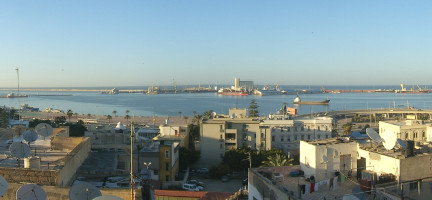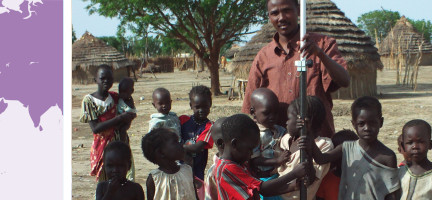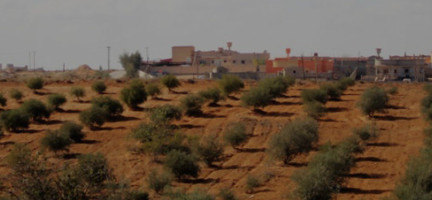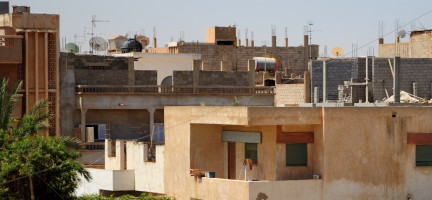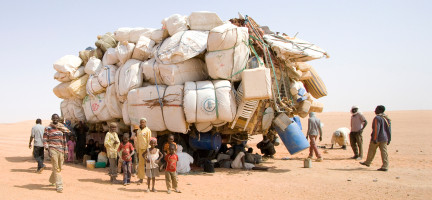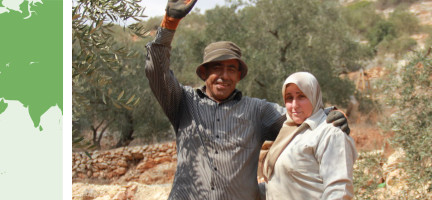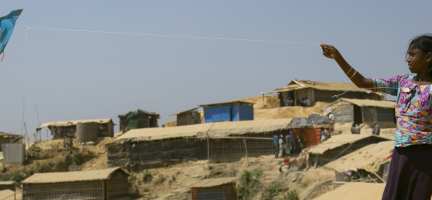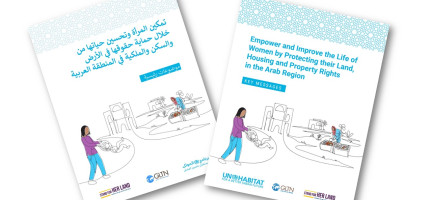Libya
Libya is a North African country bordered by the Mediterranean Sea to the north, Egypt to the east, Sudan, Chad and Niger to the south, and Algeria and Tunisia to the west. It has a total land area of nearly 1.8 million km2, 90 per cent of which is covered by desert. 85 per cent of the slightly over 7 million total population lives in urban areas. Major cities include the capital Tripoli, Benghazi, Misrata and Bayda. Despite the recent conflict and political instability, Libya is considered an upper-middle-income country, and its Human Development Index stands at 0.718 (UNDP, 2021).
This page presents a snapshot of Libya’s land sector extracted from the report “Land administration and land rights for peace and development in Libya: Analysis and Recommendations”, by UN-Habitat and the Global Land Tool Network.
Libya’s land-related legal framework developed over the centuries. It includes elements originating from Islamic law, Ottoman legal tradition, Italian colonial legislation, and the post-independence phases including the Libyan kingdom, the Jamahiriya, and the post-2011 period that followed the fall of Ghaddafi. Land administration responsibilities are spread across different institutions that develop and keep their own land-related information and datasets.
Institutions with land-related responsibilities include the Ministries of Housing and Construction, Planning, Local Government, Awqaf and Islamic Affairs, Agriculture, Livestock and Marine Resources, Transportation, Justice, Finance, Economy and Trade, and Defense. Departments and authorities with specific land administration responsibilities include the Military Survey Department, the Survey Department of Libya, the Real Estate Registration Authority, the Civil Registry Authority, the State Property Authority, the Libya Tax Authority, the Libyan Center for Remote Sensing and Space Science, the Libyan Information Authority, the Environment General Authority, the General Information Authority, and the Urban Planning Authority.
The current volatile political situation impacts the governance of the land sector. Mandates and responsibilities undergo frequent reshuffles, with negative impact on the effectiveness of institutions and their capacity to embark in the much-needed long-sighted reforms.
Land tenure
Libya’s land tenure system has been shaped by the intricate web of different legal traditions and a succession of radical changes in the country’s political orientation. These complexities and unresolved contradictions, paired with weak institutions, are underlying factors in the widespread land tenure insecurity, informality, and large number of disputes and historical grievances related to housing, land and property rights.
Libya’s land tenure system developed out of Ottoman laws, which defined five types of land categories: mulk, miri, mukufa, matruka and mawat. Mulk is land located within planned areas, such as cities and towns, and is owned by individuals. It consists of four types: (a) Al-arasat, or lands within cities and towns up to half a dunam; (b) portions of former miri lands that were transformed into mulk land with legitimate justification; (c) Ashriya, or lands distributed and owned by conquerors; and the (d) Kharajiyah, or lands that remained in the hands of their original non-Muslim residents.
Miri is land located outside of built areas. It belongs to the state’s Treasury and can be used upon its written permission for farms, pastures, and the like. Mukufa is endowed land as prescribed in Sharia law and its revenues go the Awqaf. Matruka are communal lands which are of two types: (1) public lands to be used by all people, such as public roads and squares; and (2) communal land used by a specific group of people without being subdivided, such as the pastures. Mawat, or ‘dead land’ is not owned by anyone, not used for pastures or woods, and it is typically found away from towns and inhabited areas.
Awqaf (singular waqf) or endowment land are properties set aside for charitable purposes (the use of waqf for non-charitable purposes was abolished by Law 16/1973). Individuals can donate real estate properties and other assets to the Ministry of Awqaf and Islamic Affairs that manages them and registers them as Islamic endowment to be a perpetual source of charity.
Libya’s land tenure arrangements changed over time to reflect political changes. Land tenure and property ownership were at the center of the political theory behind the 1969 coup, which was followed by the confiscation of private properties (with law 4/1978) and the nationalization of factories and private businesses in 1979.
In 1973, Law 39 abolished the customary land rights on tribal lands and transformed them into state property, removing them – at least legally – from under tribal control. While the intended objective of this decision was to facilitate land use planning, conflicts over lands negatively impacted national planning and spread the fear of being evicted and stripped from their land rights among the tribes. Pastoralists were mostly affected, and the issue has not been resolved yet. In addition to the tribal customary ownership of national lands, there has been administration boundary instability at the regional and local levels.
Law 7 of 1986 abolished private land ownership and replaced it with land use rights narrowly contingent to residential or productive uses. Citizens who legally owned land had the right to use it for working, herding, or cultivating it as long as with “his own or his family members’ effort, without exploiting the effort of others and to satisfy his, his family’s and his heirs’ needs only”. Tenants and workers of someone else’s lands and properties were declared as the rights’ holders if they met these same criteria.
The old real estate registration archive held at the Real Estate Registration Authority, which had the complete set of cadastral plates for both urban and rural areas, was burned during the unrest of 1985. The destruction of Libya’s historical records created a tabula rasa which contributed to feeding the vicious cycle that connects land tenure security and ownership rights with political or ethic affiliation.
The freeze in land registration introduced in 2011 aggravated the situation by pushing all new land transactions to informality, blocking the access to the legal land market of new properties and contributing to the increase of informal, unregulated and underserviced urban sprawl. A measure, put in place to prevent illegal transactions, is now affecting recovery and reconstruction.
The current constitution, enacted in 2012, asserts the inviolability of private homes and properties, but many land-related grievances and disputes dating back from the nationalization period are still to be resolved, complicated by the dysfunctionality of the land registration system which still persists.
Land value and price
Since 2014, land prices have skyrocketed, particularly in urban areas. The governance of land markets and the mitigation of land prices is a key priority for Libya, as it impacts housing affordability and the provision of services and infrastructure, including for the mitigation of floods.
Law 116/1972 was designed to control land prices, prohibit the speculation on urban vacant land, and ensure enough reserves for (state-led) urban development projects. The price of vacant lands within cities’ master plans was fixed to the 1964 estimated value increased of 5 per cent for each subsequent year. The law also describes how to value subdivided lands. The methodology to value public properties rented to individuals is also described by law and is based on prices from two decades ago, corresponding to 15-20 per cent of the current market value.
The Libyan land and property taxation is part of the national taxation system under the responsibility of the Libya Tax Authority. Property taxation was initially established in Ottoman times and then extended by the Italians to cover properties in both urban and rural areas. Taxes on vacant land are allocated and distributed by the Council of Ministers to municipalities, according to their urban development projects’ needs (as per Law 116/1972). Further, the land registration freeze introduced in 2011 practically stopped new properties from becoming taxable, hindering the expansion of the taxation base, and raising questions about equality. Tax collection rates are currently very low, also because many social groups and types of lands are exempted.
Land use
Before 2011, Libya’s authorities invested a great amount of attention in regulating and advancing land use strategies and plans. Libya had three urban planning and development schemes (or generations) in the period of almost four decades.
Law 3 of 2011 is comprehensive and detailed in legislating the urban planning functions. It provides definitions and objectives, defines the competent authorities, and describes the planning types and levels: national plans, regional plans, local plans, and urban plans, to be complemented by integrated utilities schemes. The country is divided into four planning regions: Tripoli, Benghazi, El-Khalij, and Fezzan Regions, which have been the cornerstone of the Libyan planning system since 1960s. In contrast, the regional and local planning divisions have changed several times, resulting in negative consequences on cities and towns’ land use, structures, and landscape.
The first planning generation covered the 1966-1980 period and resulted in the creation of master and layout plans for several cities and towns. These plans were developed at the same time as the country’s first economic plan after the discovery of oil. The second planning generation (1980-2000) addressed the lack of national integration and aimed at building a solid planning foundation, connecting town and regional plans to the national planning system.
The third generation of urban plans covered the 2000-2025 period and intended to address the shortage of lands for housing, the expansion of urban areas over arable lands, and to link regional and sub-regional planning schemes with the analysis of social and natural resources in coordination with economic planning institutions. The implementation of the third-generation plans was affected and halted by the conflict started in 2011 and the subsequent instability.
The protection of agricultural lands and forests is set by Law 5 of 1982. It defines forests, reserves, protected pastures, private forests, and trees that need to be protected and sets penalties for the violations. Law 7 of 1982 protects the environment from urban expansion and other encroachments; it describes prohibited pollutants, role of the authorities responsible for enforcement, and sets the grounds for collaboration among the Libyan Environment General Authority need and local, regional, and international actors.
Land development
In 1965, the first comprehensive urban and town planning law (Law 5) was passed to define the role and duties of the Urban Planning Authority in overseeing planning and certification, the establishment of roads, land subdivisions, building and land use and classification, regulating informal settlements, and allocating the responsibilities of involved parties. In 1977, Law 32 amended a few articles of Law 5 of 1969 and further regulated the construction of roads and highways. Building less than one hundred meters from the seashore was forbidden, except for approved touristic facilities. Municipalities were given wider powers on matters of tax collection, public utilities and infrastructure projects, housing projects and land management.
In 1984, Law 21 was enacted to regulate compensation for the expropriation of land for public benefit. Compensation only applies to land suitable for construction; properties in which the owner practices his profession, crafts, or industry; and plantations, trees, and agricultural farms. In 1992, Law 11 further defined the scope for compensation by private individuals who could claim compensation only after proving that the house or land is their only property. Law 14 of 1996 introduced the prohibition of renting housing, with few exceptions (public legal persons may rent housing owned by non-permanent residents).
Land dispute resolution
The resolution of disputes and grievances related to land, housing and property rights deserves urgent attention to unlock socio-economic development and contribute to reconciliation, peace and stability. Over the decades, tens of thousands of properties were confiscated, often without adequate or no compensation, and redistributed to categories of beneficiaries at times selected for political loyalty. An estimated 56 to 75 thousand properties were confiscated, although only a little more than 25 thousand requests were submitted to the Compensation Committee since 2006. The confiscation of private properties (law 4 of 1978) and the nationalization of all private factories, craftsmen units, and shops in 1979 have been the main source of disputes since then and still affect most landowners.
To address this issue, the Council of Ministers issued Decree 108 of 2006 that defines the procedures for compensations of Law 4 of 1978 expropriations. A High Committee led by a judge and composed of several sub-committees was established to solve the disputes and overcome the negative effects of the law over decades, particularly in Tripoli where most economic activities and properties were located. The Affected Owners Association was established to fast-track this process. Their main concerns are the delay in receiving the compensation and the value of compensation, set at only 20 percent of the current value.
Once the process of updating (and reforming) the land and property registration system will be put in motion, large numbers of competing claims and disputes will need to be addressed, which will likely require some form of transitional justice mechanism.
Spatial data infrastructure
The status of Libya’s spatial infrastructure is shaped by two contradicting factors: the significant technical and technological advances introduced by some actors, and a weak regulatory framework that hinders the capacity of the country to take full advantage of its expertise and innovation.
An aerial imagery system was established during the Italian colonialist period. It continued to be the main source of cadastral maps and the base for real estate registration during the monarchy and the Jamahiriya political period. In 1979, the Survey Department of Libya was created to be the sole creator and repository of the mapping system, aerial imagery, and spatial data infrastructure.
The spatial component of land and property registration needs to be reformed and updated to take advantage of new technologies while rebalancing the role of the various concerned actors: people, communities, land professionals, local and national institutions.
As an example, the procedures of registration outside urban areas require the involvement and approval of a knowledgeable local person (a mukhtar, an elder, or a well-known community leader) who sings the government form that indicates the land boundaries and the names of neighbours and witnesses, who also sign. A technical team then takes the filled form to the government office that approves the application and issues a temporary certificate, subject to objection and appeal. While the system works well at the local level, significant challenges appear in the consolidation, updating and compiling of information at a larger scale. There are no cadastral maps for most rural locations, the boundaries of the properties are not clear, nor digitized, nor linked to a digital cadastral map or to an analogue aerial image.
Women and land
Libyan law states that all Libyans are equal before the law, enjoy equal civil and political rights, have the same opportunities in all areas and are subject to the same public duties and obligations, without distinction on the grounds of religion, belief, language, wealth, gender, kinship, political opinion, social status, or tribal affiliation. Although Libyan laws do not explicitly discriminate against women, men are more likely to be the ones dealing with decisions and transactions related to land and properties. As per Sharia inheritance laws, women are generally entitled to half of the inheritance shares of their male counterparts however, cases of renunciation of inheritance are common and women tend to get movable assets, such as money or jewelry, rather than real properties. Sex-disaggregated data on access to, use of, and control over housing, land and properties is needed to shed light on where the gaps between laws and implementation lie.
Housing, Land and Property Rights of displaced people
Migrants, refugees, and asylum seekers are normally excluded from any type of government or public services provision. Provision of assistance to non-Libyans without legal status is criminalizing according to Libya's legal framework. This deprives thousands of people of their access to the rental market and obstructs the process of direct provision of cash for rent by the humanitarian actors. It has been observed that 2 out of 3 households do not have a written lease contract.
As of mid-2022, about one and a half million people have been “on the move” in Libya, including nearly 700 thousand returnees, more than 40 thousand refugees and asylum seekers, over 600 thousand migrants and nearly 150 thousand internally displaced people (IOM, 2023).
Evictions, both collective and individual, are common and most widespread in Tawergha and Misrata, followed by Benghazi. Most households facing eviction risks are living on privately owned land, while those risking evictions from collective sites are mostly living on government-owned land. The main reason for eviction is the inability to afford rent or utility fees, followed by the intention of the landlord to repurpose the land. The government also showed the intention to recover the land allocated to internally displaced people for its original purposes and the Ministry of Social Affairs agreed to support the relocation of each household with LYD 12,000 cash (approximately USD 2,500) in a one-off installment for rent in another place.
Further, with regard to temporary accommodation, as of end 2021, there were at least three detention centers for non-Libyans, at Al-Maya, Al-Zawiya, and Al-Zahra, hosting over 5 thousand people without access to basic services. The detention centers were formerly managed by Directorate for Combatting Illegal Migration (DCIM) of the Ministry of Interior and are currently managed by Stability Support Apparatus (SSA), an institution affiliated with to the Presidential Council.
Key interventions
Since 1979, UN-Habitat supported the Urban Planning Agency with expertise and capacity development in the areas of spatial planning, policy development, geographic information systems and urban recovery.
In February 2021, at the Second Arab Land Conference, the Libya delegation requested the support of UN-Habitat to address pressing challenges in land and property registration, land markets, land-based taxation, and the skyrocketing prices of urban land. Based on this request, and building on the long-standing collaboration, an assessment of the Libyan land sector was initiated, with a focus on housing, land and property (HLP) rights and land management and land administration.
The Roundtable on Addressing Land Administration and Land Rights Challenges to Pave the Ground for Peace and Stability in Libya, held in June 2021, brought together land and HLP practitioners from different institutions and disciplines to exchange their experiences and discuss the priorities for action. The Roundtable report is available in English and Arabic.
The Roundtable contributions also fed into the report “Land administration and land rights for peace and development in Libya: Analysis and Recommendations”. The report provides a description of the legal, institutional and spatial land-related frameworks in the country and analyses the key land administration functions: land tenure, land value, land use, land development and land disputes’ resolution. A list of recommendations complements the analysis, with the intention to trigger the interest in engaging on the proposed reforms by government institutions and partners.
A second Roundtable took place in November 2022. UN-Habitat, the Global Land Tool Network, the Ministry of Housing and with the Regional Centre for Remote Sensing of North African States (CRTEAN) arranged a discussion on land management and administration in Libya with all concerned stakeholders. The two-days event was attended by 45 participants from Libyan institutions related to land management and governance, and was divided in two parts: the presentation of key findings and recommendations from the report and small group discussions on key aspects of land administration.
Women and land campaign - In February 2021, UN-Habitat, the Global Land Tool Network, and the Arab Land Initiative launched a regional Women and Land Campaign to raise awareness on how to overcome the challenges that women face in accessing their housing, land and property rights. The Key Messages on Empowering and Improving the Life of Women by Protecting their Land, Housing and Property Rights in the Arab Region formed the basis of the regional campaign and informed national campaigns in Tunisia and Libya, launched in September 2022. The national campaign aims to empower women in Libya to claim their HLP rights, raise awareness on the role stakeholders can play in promoting women's right to land and access to land; and, to create a dialogue between stakeholders on women's right to land.
Rapid City Profiling and Monitoring System or Libya Portal - Since 2011, Libya has witnessed protracted political unrest affecting people’s lives and the national socio-economic development. Cities face severe challenges related to shortage of houses and basic services, degradation of living environment, unregulated urban sprawl, lack of land tenure security, and other challenges that constitute both short-term priorities and long-term development objectives. With the support of the EU, UN-Habitat worked with UNFPA to produce urban profiles of Benghazi, Sirte, Sebha, Kufra, Ubari, Janzour and Derna. The information collected was made available on online open digital portals, on the basis of the requests from the municipalities which needed reliable, geospatial data to guide decision making, develop evidence-based projects and programmes, and monitor the implementation of the ongoing interventions. Access here the Libya Portal.
Disclaimer
The information contained in this page is based on the body of knowledge developed by UN-Habitat, GLTN and the Arab Land Initiative’s partners. The designations employed and the presentation of the material do not imply the expression of any opinion whatsoever on the part of the Secretariat of the United Nations concerning the legal status of any country, territory, city or area, or of its authorities, or concerning delimitation of its frontiers or boundaries, or regarding its economic system or degree of development. The information may contain inaccuracies due to the data source(s) and do not necessarily reflect the views of UN-Habitat or its governing bodies.
The Libya page is still under construction. Share with us any relevant information, resource or correction to enrich our library. Contact the Arab Land Initiative at unhabitat-arablandinitiative@un.org !

